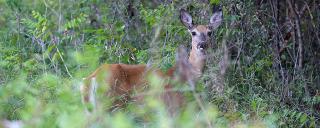 |
| Fact Sheet |
| Scientific Name |
Odocoileus virginianus |
| Description |
Averages 36 inches at the shoulder (range 30-40 inches). Bucks average 170 pounds (range 100-330 pounds); does average 130 pounds (range 90-210 pounds). Coat reddish in summer and brownish-gray in winter, with white on throat, belly and underside of tail. Only males have antlers. Main beams turn out to the sides and sweep forward, with several tines projecting off the main beam. |
Tracks |
Front track slightly larger. Front–1-3/8" - 4" L, 7/8" - 2-7/8" W. Rear–1-1/4" - 3-1/2" L, 3/4" - 2-3/8" W. Walking stride: 13" - 26". |
| Habitat |
An adaptable species living in a variety of habitats including riparian areas, forests, prairie, agricultural land and in suburban areas. |
| Food |
Whitetails are browsers, meaning they eat buds, leaves and seeds from a variety of trees, shrubs and forbs. Some favorites include green ash, willow, dogwood, apple, snow berry, acorns, and sweetclover. Deer will also take advantage of agricultural crops including corn, sunflower and alfalfa. |
| Range |
Found throughout North Dakota, most common in the eastern two-thirds. |
| Mating |
Breeding peaks in mid-November, with bucks tending one doe at a time. No permanent pair bonds. Gestation averages 202 days (range 187-222 days). |
| Young |
One to three fawns (usually two) born late May to late June, and weighing about 7 pounds. Coat reddish, with white spots on back. |
| Habits |
Most active at dawn and dusk. Does often socialize in small groups with related females from several generations. Outside of the breeding season, bucks usually alone or in small bachelor groups. |
| Fun Facts |
White-tailed deer are the most common big game animal found in North Dakota. There are more white-tailed deer now than when Lewis and Clark traveled through the state in 1804-06. |


